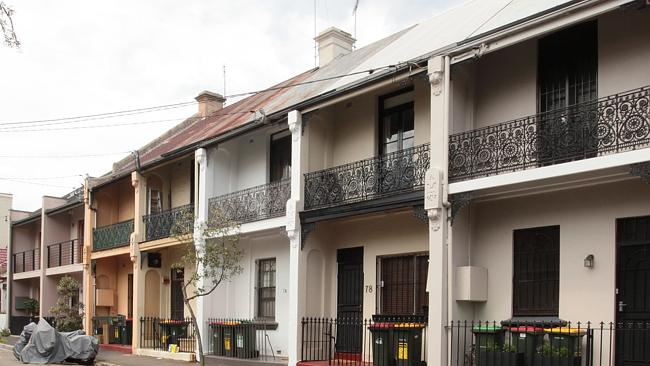Do we want to see more terraces in Sydney?
THEY are seemingly a perfect fit for big city lifestyles and a new planning push hopes to see more built in established suburbs.

TERRACE houses are a perfect fit for Sydney lifestyles and a new planning push hopes to see more of them built in established suburbs.
But it’s unclear whether changes proposed by the NSW Government will be enough to inspire developers.
The government wants to change the Medium Density Housing Code to fast-track planning approval for dwellings like terraces, villas and two-storey homes.
It has released a draft policy that would see these types of housing given automatic approval as ‘complying development’ if they meet certain criteria.
The announcement has been welcomed by many in the property sector including the Housing Industry Association, for speeding up approval times and encouraging different types of housing.
“This type of housing served us well after the first world war and they make a lot of sense,” HIA executive director NSW, David Bare told news.com.au.
“The issue you find particularly in Sydney is people work long hours or are commuting, they don’t have time to care for a large block but still want their piece of serenity somewhere.”
Terrace-style housing is seen as a great middle ground for those that can’t afford a house but don’t want to live in an apartment.
While terraces are a cheaper way of getting people into their own homes, Mr Bare believes there probably was a need for more changes in the future, such as allowing people to go up to three or four storeys.
“It is a good step in the right direction ... will it change everything? No it won’t,” Mr Bare said. “But I do think it will be more popular than some think.”
He said the planning changes would likely appeal to those wanting to transform a single storey house into a two-storey dwelling, or those in large mansions or on corner blocks that could be transformed into two or more units.
“The change clearly lends itself to more small to medium size developments,” Mr Bare said.
Easier planning approval would make it easier for people to get finance as there was more certainty about the project going ahead.
It was also clear there was demand for these types of dwellings.
When blocks of land for sale in southwest and northwest Sydney were reduced in size, Mr Bare said they were being snapped up as soon as they became available.
“As blocks become smaller, more affordable, people start buying them,” he said.
Angus Raine, chief executive officer of Raine & Horne, said terrace houses were a very popular form of living and perfectly suited to the Sydney lifestyle.

“You can have an outdoor entertaining area but not a lot of garden, and a lot of buyers don’t necessarily want a lot of garden because time is precious,” he said.
“Traditional terraces let a lot of light in and have breezeways (for cooling).”
They also appealed to many different buyers including couples with kids, empty nesters who want to downsize, first home buyers and even singles.
“It’s a very practical form of living, particularly in Sydney,” he said, adding they also fostered a sense of community because people were living “side-by-side” and shared common walls.
Mr Raine said he thought zoning did have an impact on why developers had not chosen to build them in the past and planning changes could make a difference.
“Terraces cover a broad range of buyers so I don’t think developers can go wrong,” he said.
“As long as they go with the traditional design of breezeways and light wells. The demand is definitely there.”
But whether the changes would encourage developers to build terraces over apartments was unclear.
Chris Roche, development director for property company Fridcorp, struggled to nominate a scenario where a developer would chose to build terraces instead of apartment blocks, saying the decision would be “site specific”.
“We would usually offer a more terrace-style product in areas fronting parkland where council doesn’t like height,” he said.
He said the project would still have to “stack up financially”.
Jim Minifie, productivity growth program director of the Grattan Institute, said current planning rules had created cities where high density was encouraged in CBD areas and outer suburbs while middle and inner ring areas remained fairly untouched.
“Some may say this is sensible but people are performing long commutes,” he said.
He said the argument against allowing more “clever infill” and increasing density in inner suburban areas often neglected its benefits.
“With an increase in density you can get a better local market for services like more restaurants, shops and businesses for existing residents,” he said.
Submissions on changes to the draft Medium Density Housing Code can be made until December 12.



